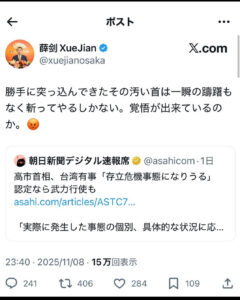In November 2025, an exchange in Japan’s Parliament unexpectedly escalated into a significant diplomatic incident between Japan and China. The catalyst was a remark by Sanae Takaichi during a Diet session, where she explained that a potential use of force over Taiwan could, in certain circumstances, qualify as a “survival-threatening situation” under Japan’s security legislation. Although her comment was a legal explanation prompted by opposition questioning—not an independent, proactive policy declaration—China interpreted the remark as a political message.
The situation intensified after the Chinese Consul General in Osaka posted a highly aggressive message on X (formerly Twitter), prompting strong reactions inside Japan and ultimately leading Beijing to issue diplomatic protests and warnings. This article examines the entire sequence in a balanced manner, focusing on what was actually said, why China reacted so strongly, and what the episode reveals about the structural sensitivities in Japan–China relations.
1. What Actually Happened in the Diet: The Context Behind Takaichi’s Remarks
Takaichi’s controversial statement did not arise from an attempt to unilaterally shift Japan’s Taiwan policy or send a message to China. Instead, it emerged from a series of highly detailed questions posed by opposition lawmakers.
Opposition members pressed Takaichi to clarify:
-
How a Taiwan contingency might affect Japan’s legal framework for national defense
-
Whether a Taiwan-related conflict could fall under a “survival-threatening situation”
-
How the 2015 security laws apply to scenarios involving Japan’s close partners
In response, Takaichi provided a cautious, textbook explanation of existing law. She repeatedly emphasized hypotheticals and refrained from naming specific countries. The structure of the exchange makes clear that she was providing legal clarification, not voluntarily articulating a new foreign or security policy.
2. What “Survival-Threatening Situation” Actually Means Under Japanese Law
Japan’s “survival-threatening situation” (sonritsu-kiki-jitai) is often misunderstood, both domestically and internationally. Introduced under the 2015 security legislation, the concept allows Japan to exercise only a narrowly limited form of collective self-defense.
A survival-threatening situation requires:
-
A clear and imminent danger that Japan’s existence or the lives and freedoms of its people will be fundamentally compromised
-
No other appropriate means to protect Japan
-
Approval from the Cabinet and, in principle, the Diet
Crucially, even when the criteria are met, Japan is only allowed to use the minimum necessary force for self-defense. It cannot initiate offensive operations, cannot use force as a means of coercion abroad, and cannot “attack” Taiwan or China under any scenario.
Thus, Takaichi’s explanation did not suggest an expanded military role for Japan; it merely reflected the structure of Japanese constitutional and statutory law.
3. Japan’s Taiwan Policy Has Not Changed
Despite some external assumptions, Takaichi’s remarks do not represent a shift in Japan’s longstanding Taiwan policy. Several layers of evidence support this conclusion.
Japan’s diplomatic stance has been unchanged since 1972.
Japan recognizes the government of the People’s Republic of China as the sole legal government of China, but it has never endorsed Beijing’s claim that Taiwan is an inseparable part of China. Japan maintains practical, non-governmental ties with Taiwan—a framework unchanged for over 50 years.
Japan’s security assessments have long acknowledged Taiwan’s importance.
Since the early 2010s, and especially in Defense White Papers from 2021 onward, Japan has repeatedly stated that peace and stability in the Taiwan Strait are critically important for its own security.
Past Diet answers have also acknowledged potential legal implications.
Successive administrations have explained in general terms that certain regional conflicts—depending on their nature—could be assessed as survival-threatening situations.
In short, Takaichi’s comment aligns perfectly with:
-
Existing legal interpretations
-
Previous government explanations
-
Longstanding diplomatic positions
-
Published defense assessments
No procedural steps associated with major policy shifts—such as Cabinet decisions or official reinterpretations—were taken or even suggested.
The perception of a “policy change” is therefore the result of misinterpretation, not substance.
4. Why China Still Reacted Strongly—Understanding Beijing’s Perspective
Although Japan’s legal and diplomatic positions remain unchanged, China interpreted the exchange differently. Taiwan is regarded by Beijing as a “core interest”, an issue on which the Chinese government tolerates no ambiguity.
From China’s perspective:
-
The remarks were made in the Diet, an official setting
-
They were made by a senior LDP figure and former Cabinet minister
-
They explicitly connected Taiwan and Japan’s security legislation
Even if legally technical, the comments appeared as a public signal that Japan might consider a Taiwan conflict relevant to its own defense posture. The symbolic meaning overshadowed the legal nuance.
5. The Osaka Chinese Consul General’s Threatening Post

Tensions escalated dramatically when Xue Jian, the Chinese Consul General in Osaka, posted the following on X:
“If that filthy head dares to charge in, it should be cut off without hesitation. Are you ready?”
The wording clearly evokes physical violence and was widely perceived in Japan as threatening, violent, and even suggestive of assassination or bodily harm. The Japanese government lodged a protest, and media across Japan criticized the message as incompatible with diplomatic norms.
6. Why Beijing Did Not Distance Itself—The Role of “Face” and Nationalism
Despite international criticism, the Chinese government did not publicly rebuke or remove the Consul General. This is not surprising given China’s diplomatic culture, where “face” (mianzi) and perceived strength are central considerations.
-
Acknowledging the Consul General’s statement as inappropriate could have been seen domestically as weakness
-
Nationalistic sentiment in China tends to reward strong rhetoric on Taiwan-related issues
-
Beijing often prefers projecting unity between officials abroad and the central government
Rather than distancing itself, the Chinese Foreign Ministry summoned Japan’s ambassador and issued warnings, thereby reinforcing the impression that the Consul General’s tone—while extreme—was consistent with China’s broader posture.
7. China’s Diplomatic and Economic Responses
Following the incident, China escalated its response:
-
Issuing official protests
-
Warning that Japan must correct its “wrong remarks”
-
Suggesting that trade, travel, or educational exchanges could be affected
-
Criticizing Japanese products and diplomatic behavior in state media
These steps signaled that Beijing was prepared to use multiple diplomatic tools—not only rhetoric—to respond to perceived Japanese involvement in Taiwan issues.
8. Could Japan Attack China or Taiwan? Legally and Politically, the Answer Is No
One persistent misconception deserves clear correction:
Japan cannot use force to attack China or Taiwan under its existing security laws.
Even in a survival-threatening situation:
-
Japan may use force only to defend itself
-
The threshold for action is extremely high
-
Offensive operations are constitutionally prohibited
-
The exercise of collective self-defense remains heavily restricted
Thus, interpreting Takaichi’s remarks as implying Japanese military intervention in Taiwan is legally unfounded.
9. What This Episode Reveals About Japan–China Relations
This incident demonstrates the structural gap between how Japan and China interpret political and security signals:
-
Japan views Diet discussions as part of domestic legal clarification
-
China views the same discussions as potential foreign-policy statements
-
Social media posts by diplomats can exacerbate tensions instantly
-
Taiwan remains a flashpoint where misunderstandings can escalate rapidly
Managing this gap—through clearer communication, careful parliamentary language, and diplomatic engagement—will be essential for stability in East Asia.
Conclusion
Sanae Takaichi’s remarks did not represent a policy shift and were entirely consistent with Japan’s long-established legal and diplomatic positions. Nevertheless, China’s intense reaction—and the Consul General’s threatening post—revealed the deep sensitivities surrounding Taiwan and the ease with which routine parliamentary exchanges can transform into diplomatic friction.
As regional tensions continue to rise, Japan and China will need to navigate these issues with far greater precision and restraint.










